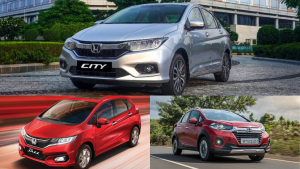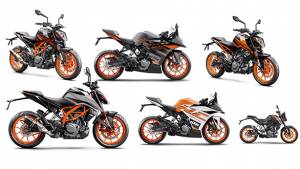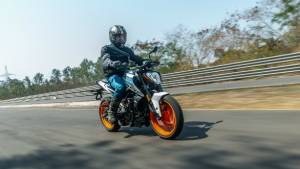Rush Hour 2: Motorcycles versus cars in Pune traffic
Cities are the engines of the economy. And the friction that slows progress and economic output are many. Rush hour is the one we are dealing with today. In 2006, we took every available mode of transport to analyse Mumbai's rush hour (hours and hours, actually). This time, we're heading to Pune, a booming Tier-I town.
Our route was an actual commute. Abhay's parents live in one of the newer suburbs and he used to commute to the city centre, our office. Our route would see fast roads, really crowded stretches and as is typical for smaller towns, many signalised intersections the flyovers that alleviate the delays are under construction. So 23km of roads and traffic that should be representative of India's Tier-I towns.
Among the motorcycles, a larger displacement motorcycle represented the premium commuters. And in that vein, a slightly 'hardcore' rider. That's Shumi and the KTM Duke 200. Then we had Joe representing (snigger) the average Joe on the Honda Dream Yuga the entry-level commuter. I rode the Honda Dio to represent scooters I'm good with small wheels.
The cars? Nano with Ashok in it for the small cars, Gaurav in the Brio for the mid-level hatches, Rishaad in the Skoda Rapid as the mid-level manager-type in a C-segment sedan, Halley as the small company CEO in a BMW 3 Series and finally Abhay (finally got to play) the tycoon in a Mistubishi Montero, the SUV type. We didn't employ chauffeurs because we believe cars are meant to be driven, not driven in.
The route
A typical Pune commute and I'm going to break it down into four sectors for ease of narration. Sector one is from Abhay's home near Dange chowk to the old Mumbai-Pune highway, a stretch that has some broken roads, well surfaced tarmac, a couple of narrow flyovers and a signal before the highway stretch near Chinchwad station.
Sector two is a long section of the old Mumbai-Pune highway running up to the Harris bridge. It runs straight for about 10km but has an important entry ramp and a few crucial signals. Sector three is from the Harris bridge to the Sancheti Hospital signal, seven kilometres of straight road but peppered with even more stop signals. Finally sector four is three kilometres jam packed with traffic with one crucial U-turn thrown in.
The Running start
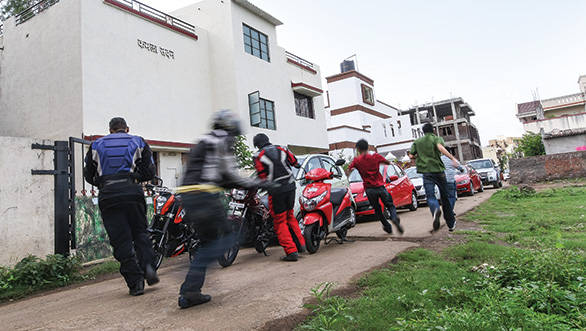 In typical Le Mans style, we all scurried for our bikes and cars
In typical Le Mans style, we all scurried for our bikes and cars
We lined up a Le Mans style running start, and then we're off running literally! Gaurav received a small handicap as he had to take pictures of us. Shumi and Joe get off to a flyer over the broken road outside Abhay's place and take an early lead. Behind them, Halley and Ashok with Rishaad were in hot pursuit. Abhay was slow to get off the line in the big Montero with Gaurav just edging ahead in the Brio and I ended up last on the Dio, it was the least comfortable on the lunarscape outside Abhay's house. There was little separating the bikes and the cars at this point but then came a flyover which is undivided and a two lanes only. The motorcycles were able to use this to their advantage and open up a gap between the cars and the scooter. There are many such flyovers in Pune and other developing cities and this meant that the motorcycles and scooter could pop out into the opposing lane when traffic relents and quickly get far, far ahead. Indian traffic expects this so it isn't as unsafe as it might sound either. Then at the intersection that followed, Joe and Shumi crossed through just before the signal turned red and took off into the distance.
Lesson: The motorcycles handled the bad roads better than scooters because of bigger wheels, better suspension and more power. SUVs in theory should be faster but when the road is scattered with slow moving vehicles, even they cannot make time.
The Highway run
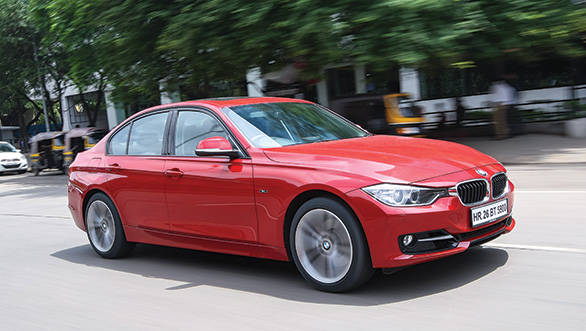 The 3 Series gets off to a flyer of a start
The 3 Series gets off to a flyer of a start
On the long straight section Shumi and Joe were far in the lead while the cars made the most of the open roads on the route. Here the SUV came into its own with Abhay moving ahead of the Brio, Rapid and the Dio.
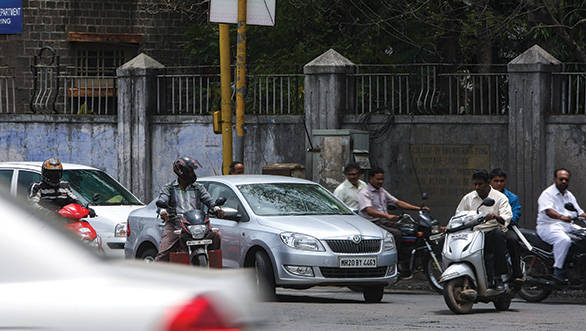 Rishaad and I, waiting at the lights after missing an exit
Rishaad and I, waiting at the lights after missing an exit
Meanwhile Rishaad and I both missed a crucial entry ramp to the highway and then had to go through three additional signals on a service road while the rest were on the highway. The two signals at the end of this section helped the Dio make up the lost time, creeping up beside Halley's BMW just before the Harris bridge.
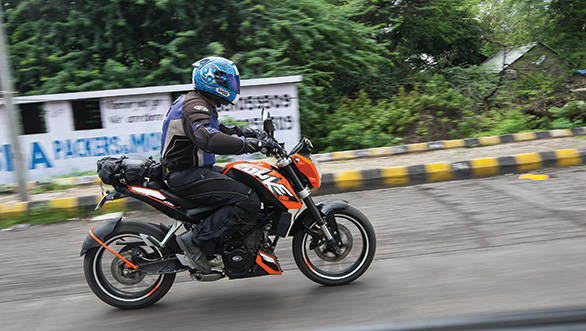 Shumi speeds off into the distance
Shumi speeds off into the distance
Lesson: Driving or riding frantically in traffic feels rushed and quick but rarely is. The less rushed riders and drivers were able to see the ramp and had sufficient time to adjust and take the ramp - none of us intimately knew this route apart from Abhay. This is a common mistake, and was also highlighted by the difference in Shumi and Joe's riding styles. Shumi rides like a seasoned traffic veteran, calm, quick and willing to back off to pick better gaps rather than blast through without a plan. Joe made up time by riding the Yuga harder but you could easily argue that Joe's safety envelope was a shrink wrapped package rather than the hot air balloon that Shumi (how stunningly appropriate that analogy is Bert) had around him. Conversely, Shumi could give up the safety margin and disappear on the KTM, but that isn't safe. It can be done, but don't do it. Arrive, but not at the hospital.
The traffic lights
Crossing the bridge, I slipped ahead of the cars as they tried to make their way through the cloud of motorcycles, scooters and cycles that slowly enveloped them at every signal. Halley had Ashok, Rishaad, Abhay and Gaurav behind him but I still could not see any sign of Shumi or Joe as they had disappeared on us. This portion of our test was filled with traffic lights and we slowly went from light to light holding positions and twiddling thumbs.
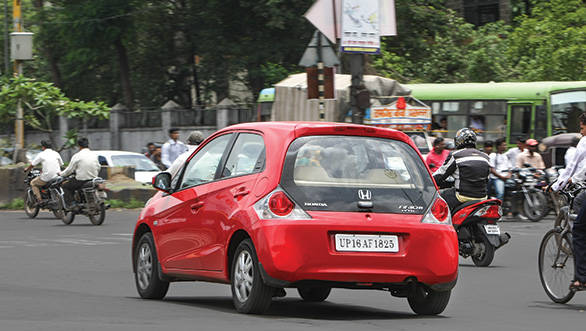 I managed to slip past the Brio in traffic
I managed to slip past the Brio in traffic
Lesson: Bikers have to slowly creep to the front row (if you don't other bikers yell at you!) and then take off. Get enough signals and you can make up immense amounts of time on other vehicles. But you need to have a significantly quicker motorcycle to make time on other two-wheelers. Cars and SUVs, on the other hand, get bogged down behind slower accelerating vehicles where bikes can usually change a lane or two and find a quicker path ahead. The smaller the car the less this is an issue. Small size, then is more of a weapon in traffic than power. So if your commute has loads of signals, you might be happier in a puny hatch than in a big SUV.
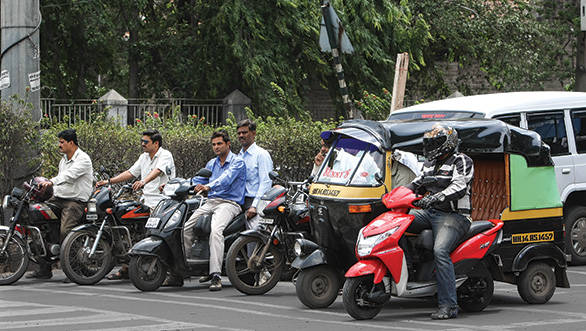 Getting the scooter to the front at lights was important
Getting the scooter to the front at lights was important
In India, bikes will also sometimes use more than the road itself and sometimes the traffic cops will encourage this behaviour. At one of the signals along the way, only the bikes were encouraged to use a dirt slip road by the cops to take the front row at the signal. Again, advantage to the bikes.
The chequered table cloth
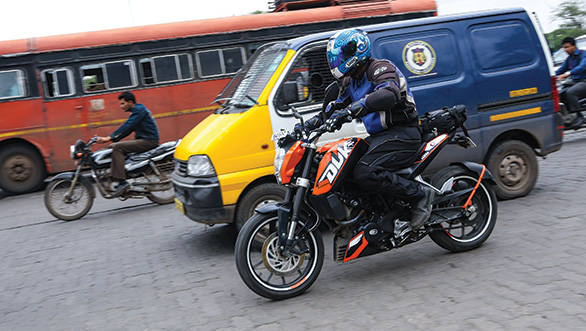 Shumi cruising along, far ahead of us all
Shumi cruising along, far ahead of us all
Shumi's KTM, having been in the lead for the whole race was impeded in the last kilometre by a broken down truck and had to share honours with Joe's Dream Yuga, 23km covered in 28 minutes. The Dio reached two minutes later. The BMW sped to the finish four minutes after the KTM, the first car there. Then a surprise Ashok's Nano managed to squeeze through some gaps and finished in fifth just two minutes slower than the 245PS BMW. Gaurav who was last for most of the race in the Brio, managed to leap frog the Rapid and the Montero finishing in sixth, an additional three minutes behind the tiny Nano. Rishaad showed up 30 seconds later followed by Abhay and the Montero, a full ten minutes after the motorcycles.
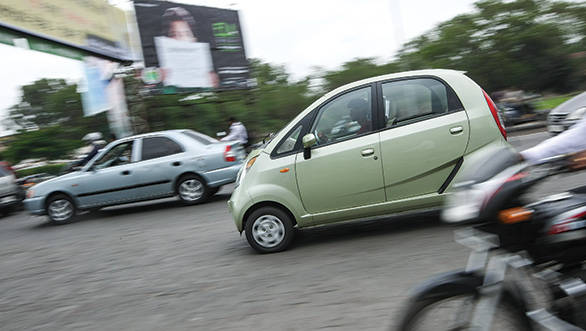 The Nano was able to weave through gaps other cars couldn't
The Nano was able to weave through gaps other cars couldn't
Lesson: Traffic is random. On another day without the truck, the Yuga could be minutes behind Shumi. Which is the reason why racing or trying to make up time in traffic is a fruitless exercise in addition to being disastrously unsafe. Plan ahead and leave home early to reach on time. A cool-headed calm swiftness - Shumi's eternal advice in Better Riding - is better overall than a racing driver's approach to the problem. And look at it this way. The SUV took just 10 minutes longer than the fastest motorcycle over a 23km commute. Ten minutes is a lifetime in an ambulance, granted. But on your way to work?
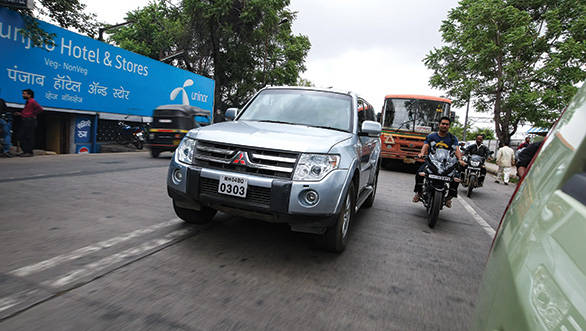 The Montero's bulk dictated a crawl through traffic
The Montero's bulk dictated a crawl through traffic
Conclusion
Motorcycles, as expected, were clearly the quickest way to get across town. Four wheelers can't do anything about this because they need larger gaps. That said, the difference isn't large enough to be significant. So get over it. Speeding in traffic simply doesn't pay. The pro for cars is obviously, comfort air-conditioning, music, no muck and far greater safety if you have an incident. Among the bikes, the KTM enjoyed the advantage of a taller stance because it allows the rider to look further ahead and capitalise on better gaps. The same is true for the SUV as well and while it's size means you can't make progress, it's imposing nature makes people give way easier and quicker when you want to pass. As in an aggressive looking vehicle is a great tool to drive defensively. Traffic impedes cars. Halley found that xenon lamps on the BMW help encourage people to give way. Ashok thoroughly enjoyed the small size of his Nano, using gaps the other cars wouldn't dare put a wheel into. To the point where the Nano traversed the commute quicker than all other cars save for the BMW, very impressive.
The biggest leveller in traffic is the signalised intersection. They will null any advantage you can make up. Unless you can locate the speed at which you get green after green. Most big roads in urban India already have green corridors official term. At that speed, you hit green after green. The proviso is that it is usually set low, say 40kmph so you have to understand that you need to slow down to save time. Again, this is easier to discover when you use the road daily - on your commute - than like us, for a test, for that day only.
We also discovered something urban planners have already documented big towns run, walk and drive faster than smaller towns. Pune traffic was less dense and less aggressive but distinctly slower when jammed as well as when flowing smoothly. Which means that if you're a city dweller passing through a smaller town, you need to have more patience.
Then we looked at the cost of the trip and discovered that if you leave aside the money you pay to own private transport, public transport actually costs more per trip than two-wheelers and the Nano. And because our public transport isn't a model of efficiency it consumes immense amounts of time and is with rare exception the least comfortable or convenient way to travel. The KTM was the most expensive motorcycle here, costing us Rs 63 for the 23km trip while the cars and SUV cost an average of Rs 160.
Pune's traffic is steadily increasing and there will soon come a time when it will be as jammed as Mumbai is I guess rush hour is a mark of a city becoming a metropolis. But the biggest moral in this story for me is simply this. Rushing through this chaos rarely works and leaving early and driving or riding calmly is vastly superior to frantically dicing through traffic. All it will get you, at best, is time for an extra cup of chai before you punch in for work.
Starts Rs 41.7 Lakhs
1998cc
Automatic
190
400
16.13 Kmpl
Starts Rs 7.49 Lakhs
999cc
Automatic
110
175
18.97 Kmpl
Starts Rs 59,990
109cc
Automatic
7.76
9.00
-NA-
Starts Rs 54,909
109cc
4-Speed
8.31
9.09
-NA-
